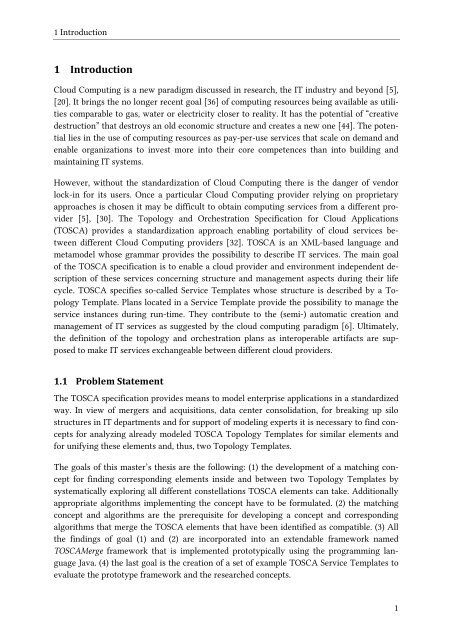Merging of TOSCA Cloud Topology Templates - IAAS
Merging of TOSCA Cloud Topology Templates - IAAS
Merging of TOSCA Cloud Topology Templates - IAAS
Create successful ePaper yourself
Turn your PDF publications into a flip-book with our unique Google optimized e-Paper software.
1 Introduction<br />
1 Introduction<br />
<strong>Cloud</strong> Computing is a new paradigm discussed in research, the IT industry and beyond [5],<br />
[20]. It brings the no longer recent goal [36] <strong>of</strong> computing resources being available as utilities<br />
comparable to gas, water or electricity closer to reality. It has the potential <strong>of</strong> “creative<br />
destruction” that destroys an old economic structure and creates a new one [44]. The potential<br />
lies in the use <strong>of</strong> computing resources as pay-per-use services that scale on demand and<br />
enable organizations to invest more into their core competences than into building and<br />
maintaining IT systems.<br />
However, without the standardization <strong>of</strong> <strong>Cloud</strong> Computing there is the danger <strong>of</strong> vendor<br />
lock-in for its users. Once a particular <strong>Cloud</strong> Computing provider relying on proprietary<br />
approaches is chosen it may be difficult to obtain computing services from a different provider<br />
[5], [30]. The <strong>Topology</strong> and Orchestration Specification for <strong>Cloud</strong> Applications<br />
(<strong>TOSCA</strong>) provides a standardization approach enabling portability <strong>of</strong> cloud services between<br />
different <strong>Cloud</strong> Computing providers [32]. <strong>TOSCA</strong> is an XML-based language and<br />
metamodel whose grammar provides the possibility to describe IT services. The main goal<br />
<strong>of</strong> the <strong>TOSCA</strong> specification is to enable a cloud provider and environment independent description<br />
<strong>of</strong> these services concerning structure and management aspects during their life<br />
cycle. <strong>TOSCA</strong> specifies so-called Service <strong>Templates</strong> whose structure is described by a <strong>Topology</strong><br />
Template. Plans located in a Service Template provide the possibility to manage the<br />
service instances during run-time. They contribute to the (semi-) automatic creation and<br />
management <strong>of</strong> IT services as suggested by the cloud computing paradigm [6]. Ultimately,<br />
the definition <strong>of</strong> the topology and orchestration plans as interoperable artifacts are supposed<br />
to make IT services exchangeable between different cloud providers.<br />
1.1 Problem Statement<br />
The <strong>TOSCA</strong> specification provides means to model enterprise applications in a standardized<br />
way. In view <strong>of</strong> mergers and acquisitions, data center consolidation, for breaking up silo<br />
structures in IT departments and for support <strong>of</strong> modeling experts it is necessary to find concepts<br />
for analyzing already modeled <strong>TOSCA</strong> <strong>Topology</strong> <strong>Templates</strong> for similar elements and<br />
for unifying these elements and, thus, two <strong>Topology</strong> <strong>Templates</strong>.<br />
The goals <strong>of</strong> this master’s thesis are the following: (1) the development <strong>of</strong> a matching concept<br />
for finding corresponding elements inside and between two <strong>Topology</strong> <strong>Templates</strong> by<br />
systematically exploring all different constellations <strong>TOSCA</strong> elements can take. Additionally<br />
appropriate algorithms implementing the concept have to be formulated. (2) the matching<br />
concept and algorithms are the prerequisite for developing a concept and corresponding<br />
algorithms that merge the <strong>TOSCA</strong> elements that have been identified as compatible. (3) All<br />
the findings <strong>of</strong> goal (1) and (2) are incorporated into an extendable framework named<br />
<strong>TOSCA</strong>Merge framework that is implemented prototypically using the programming language<br />
Java. (4) the last goal is the creation <strong>of</strong> a set <strong>of</strong> example <strong>TOSCA</strong> Service <strong>Templates</strong> to<br />
evaluate the prototype framework and the researched concepts.<br />
1
















